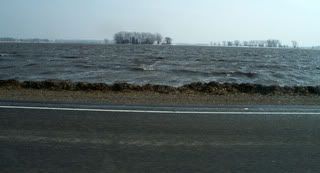
A few times a year, I notice signs of beaver activity on the river bank. Usually, it's a nomadic beaver, stopping only to refuel on the dense willow shoots or elm bark. This river isn't deep enough to support year-round living. This summer, an ambitious beaver decided to change that. I started to see entire trees chewed down, cut to length, and then stuck into the soft river bottom. It was fun to watch the process of dam building, and I found myself amazed at the animal's ingenuity. The dam was well-designed, from its placement next to a big old log for support, to its curving outline that bent with the strongest current instead of fighting it. It was a humble structure at first, but slowly grew under the patient work and eye of its beaver builder. The water level behind the dam rose a few inches over a few weeks. A pond was forming, and large schools of creek minnows swam in the deep pools. The fish attracted herons, and the mink and otter that left tracks telling their story of nighttime activity.
Soon, less friendly human eyes fell upon the dam. A local trapper was contacted by the watershed district and I noticed snares placed over beaver trails on the bank. The trapper's technique was haphazard compared to the beaver's. One evening, as I sat upon the big old log listening to the water cascade over the dam, I actually saw the animal for the first time. It wasn't a large beaver; it was probably out on its own for the first summer of exploration and independent life. The beaver saw me, too. It circled in the water, dunked a few times, then swam under a bank overhang and disappeared (possibly into a den). I was concerned that this beaver, not realizing that it lived in drainage ditch, wouldn't survive the summer because of the tangle of snares set nearby. There aren't a lot of beavers living in this area; goodness knows we could use more wildlife and less sugar beets.
In the end, humans had no say in the matter. An October storm event released several inches of rainfall. The river chose and churned. The beaver dam of sticks and mud flexed and moved, eventually separating and floating downstream in many pieces. The beaver most likely moved on to a place with more stable living conditions. I needn't have concerned myself any more than the watershed district needed to about this animal. The difference is, I hope the beaver returns next year and the drainage advocates do not.














